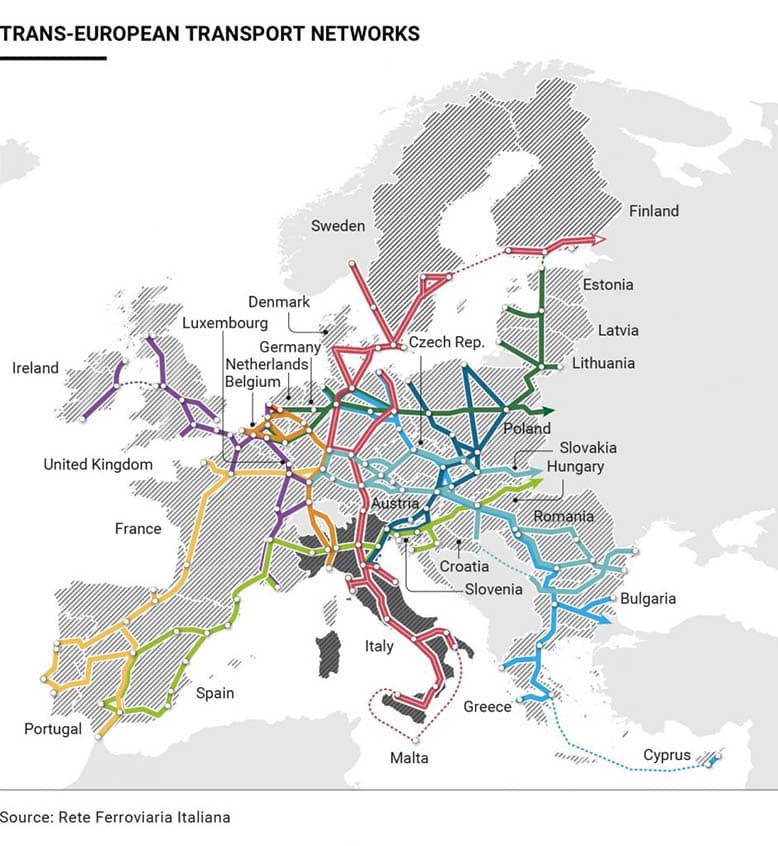
From Sicily to Piedmont. From the extreme tip of Italy’s boot to the border with Austria, France and Switzerland. Fast or high-speed train travel in Italy will be more than just between Turin to Salerno, on the busy line that stops in Milan, Bologna, Florence, Rome and Naples. The service will also link Milan to Brescia in Lombardy and Padua to Mestre in the Veneto, completing the link between Turin to Venice. New tracks that are being planned or designed will eventually extend to Puglia, Calabria and Sicily, connecting cities in the south with those in northern Europe.
According to the UIC (Union Internationale des chemins de fer), Italy’s fast and high-speed network covers 1,467 kilometres, out of the country’s 16,781 total kilometres. For high-speed, the country has the fourth-longest network in Europe, after Spain (2,852 kilometres), France (2,814 kilometres), and Germany (1,658 kilometres).
But the ranking will change because the European Union’s development plan for high-speed rail will have a considerable impact on Italy, improving its domestic network as well as its links to the rest of Europe.
Europe and TEN-T networks
In a connected and increasingly integrated Europe, high-speed rail is becoming one of the most effective tools for sustainable mobility, capable of considerably reducing travel times between cities and bringing people closer together. That is why the European Union wants to build TEN-T corridors travelling from the Baltic Sea to the Adriatic; from the Russian-Finnish border to the Mediterranean; from Rotterdam to Genoa; and linking the south of Spain to Hungary. These corridors under construction all across the continent are collectively called TEN-T (for Trans-European Transport Network). There are nine multi-modal corridors considered strategic by the European Union, four of which involve Italy (the Baltic-Adriatic, the Scandinavian-Mediterranean, the Rhine-Alps and the Mediterranean). The 2013 European regulation that established the TEN-T network provides for the construction of these corridors, or their strengthening if they already exist, by 2030.

The new lines under construction
Italy is doing its part in the European project. Some lines are already under construction, and others will be implemented soon. Among those under way is a strategic project for economic development of Italy’s industrial northwest region, the Terzo Valico dei Giovi, which will connect Genoa to Milan in less than an hour and is part of the European corridor which should link the port of Rotterdam with that of Genoa. The work is being carried out by the Cociv consortium (of which Salini Impregilo is a part), employing more than 2,500 people directly and indirectly during peak periods. The Naples-Bari works are also underway, upgrading the existing line to allow trains to reach a maximum speed of 250 kilometres per hour. In Sicily, the upgrade of the Palermo-Catania line was launched on March 25 by Pietro Salini, chief executive of Salini Impregilo, which will carry out the work, and by the Infrastructure Minister Danilo Toninelli. The Sicilian high speed line, whose construction will employ 1,000 people, joins other TEN-T projects already under way to Brescia and Verona, and Verona to Padua.
Some of the most important projects connect Italy with northern Europe, such as the Turin-Lyon line, and the 55-kilometre-long Brenner Base Tunnel, built in part by Salini Impregilo, which should be completed by 2025. The line will connect Fortezza in Italy with the Austrian city of Innsbruck. Once finished, it will be the longest railway tunnel in the world. It is a strategic transport link which is part of the European project that aims to unite Verona with Munich, eventually creating a high-speed rail link between Berlin and Palermo.
A great tool for sustainable mobility
The European rail network is already at the heart of the continent’s mobility. A study, “Rail 2050 Vision, carried out by the European Rail Research Advisory Council, calculates that 400 billion trips are made every year in European metropolitan areas, 15% of which on public transport. In the field of public transport, the rail network accounts for 45% of the total. In absolute terms, every year European commuter railways carry 8.9 billion passengers, just a little less than urban subways (9.5 billion).
The European railway industry employs 2.3 million people and produces gross added value of €143 billion (1.1% of Europe’s gross domestic product). Including the sector’s total job count at suppliers and rail related activities, the industry employs four million for €250 billion of added value. The industry therefore is a significant economic driver, and also makes a large contribution from a sustainable development perspective, encouraging trade but reducing the impact of transport on the environment.

